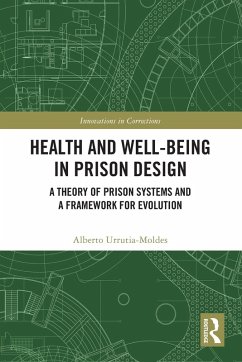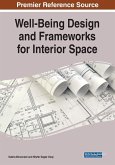Alberto Urrutia-Moldes
Health and Well-Being in Prison Design
A Theory of Prison Systems and a Framework for Evolution
Alberto Urrutia-Moldes
Health and Well-Being in Prison Design
A Theory of Prison Systems and a Framework for Evolution
- Broschiertes Buch
- Merkliste
- Auf die Merkliste
- Bewerten Bewerten
- Teilen
- Produkt teilen
- Produkterinnerung
- Produkterinnerung
This book establishes a new framework for the architectural design of prisons in non-repressive prison models to promote the health and well-being of all prison users.
Andere Kunden interessierten sich auch für
![Urban Environments and Health in the Philippines Urban Environments and Health in the Philippines]() Mary Anne Alabanza AkersUrban Environments and Health in the Philippines52,99 €
Mary Anne Alabanza AkersUrban Environments and Health in the Philippines52,99 €![Notes on Cylinder Bridge Piers and the Well System of Foundations Notes on Cylinder Bridge Piers and the Well System of Foundations]() John NewmanNotes on Cylinder Bridge Piers and the Well System of Foundations17,99 €
John NewmanNotes on Cylinder Bridge Piers and the Well System of Foundations17,99 €![Type Plans and Elevations of Houses Designed by the Ministry of Health in Connection With State-aided Housing Schemes Type Plans and Elevations of Houses Designed by the Ministry of Health in Connection With State-aided Housing Schemes]() Type Plans and Elevations of Houses Designed by the Ministry of Health in Connection With State-aided Housing Schemes15,99 €
Type Plans and Elevations of Houses Designed by the Ministry of Health in Connection With State-aided Housing Schemes15,99 €![The Illustrated Guide to Mundesley-on-Sea, Containing Brief Sketches of Many Places of Interest in the Neighbourhood, as Well as Several Excellent Ill The Illustrated Guide to Mundesley-on-Sea, Containing Brief Sketches of Many Places of Interest in the Neighbourhood, as Well as Several Excellent Ill]() Lemmon LingwoodThe Illustrated Guide to Mundesley-on-Sea, Containing Brief Sketches of Many Places of Interest in the Neighbourhood, as Well as Several Excellent Ill14,99 €
Lemmon LingwoodThe Illustrated Guide to Mundesley-on-Sea, Containing Brief Sketches of Many Places of Interest in the Neighbourhood, as Well as Several Excellent Ill14,99 €![Experiencing Architecture Experiencing Architecture]() Steen Eiler RasmussenExperiencing Architecture22,99 €
Steen Eiler RasmussenExperiencing Architecture22,99 €![Well-Being Design and Frameworks for Interior Space Well-Being Design and Frameworks for Interior Space]() Valeria MinuccianiWell-Being Design and Frameworks for Interior Space129,99 €
Valeria MinuccianiWell-Being Design and Frameworks for Interior Space129,99 €![Modern Cottage Architecture, Illustrated From Works of Well-known Architects; Modern Cottage Architecture, Illustrated From Works of Well-known Architects;]() Modern Cottage Architecture, Illustrated From Works of Well-known Architects;17,99 €
Modern Cottage Architecture, Illustrated From Works of Well-known Architects;17,99 €-
-
-
This book establishes a new framework for the architectural design of prisons in non-repressive prison models to promote the health and well-being of all prison users.
Produktdetails
- Produktdetails
- Verlag: Routledge
- Seitenzahl: 290
- Erscheinungstermin: 29. Januar 2024
- Englisch
- Abmessung: 229mm x 152mm x 16mm
- Gewicht: 424g
- ISBN-13: 9780367765637
- ISBN-10: 0367765632
- Artikelnr.: 69927985
- Herstellerkennzeichnung
- Libri GmbH
- Europaallee 1
- 36244 Bad Hersfeld
- gpsr@libri.de
- Verlag: Routledge
- Seitenzahl: 290
- Erscheinungstermin: 29. Januar 2024
- Englisch
- Abmessung: 229mm x 152mm x 16mm
- Gewicht: 424g
- ISBN-13: 9780367765637
- ISBN-10: 0367765632
- Artikelnr.: 69927985
- Herstellerkennzeichnung
- Libri GmbH
- Europaallee 1
- 36244 Bad Hersfeld
- gpsr@libri.de
Alberto Urrutia-Moldes holds a PhD in prison architecture from the University of Sheffield in the UK. He also has a BSc in Industrial Engineering (2008) and a BSc in Construction Management (1993), both from the University of the Bío-Bío in Chile. After graduating as Construction Manager, he started working in the construction industry for private companies until 1998, when he was appointed head of the regional office of infrastructure at the Bío-Bío Regional Directorate of the Chilean prison service in the city of Concepción. In this capacity, Alberto was responsible for addressing the needs of the 24 prison and parole facilities across 14 cities in the Bío-Bío region. He was later appointed as the head of the projects and planning office at the same regional directorate. In tandem with his job in the Chilean prison service, he has worked since 2006 as a part-time lecturer in construction management at the School of Construction Engineering at the University of the Bío-Bío. In 2012 he co-organised - with the Faculty of Architecture at the University of the Bío-Bío - the first conference in prison architecture held in Chile, and then co-edited the book 1st Seminar of Prison Architecture for Social Reinsertion, which contains the main presentations of the two-day conference. In 2014 he moved to the UK, where he started his PhD programme, being awarded a Doctoral degree in March 2020.
INTRODUCTION
PART I: THEORETICAL AND HISTORICAL FOUNDATIONS
1: Theoretical standpoints
2: Punishment and prison design
3: Evolution of prison models from the birth of the prison to the nineteenth century
4: Prison models: recent history, and development from the twentieth century to the present
PART II: HUMAN FACTORS AND THE IMPORTANCE OF THE HEALTH AND WELL-BEING OF PRISON USERS
5: Why should prison design promote health and well-being?
6: Environmental stressors to health
PART III: CASE STUDIES FROM THE HYBRID, THE SECURITY, AND THE REHABILITATION MODELS
Introduction to Part III
7: International Advisors
8: The Hybrid prison model
9: The Security prison model
10: The Rehabilitation prison model
PART IV: TOWARDS A NEW OUTLINE FRAMEWORK FOR PRISON DESIGN
11: Cross-case comparison of prison models
12: Towards a new outline framework to design prisons that promote health and well-being
PART I: THEORETICAL AND HISTORICAL FOUNDATIONS
1: Theoretical standpoints
2: Punishment and prison design
3: Evolution of prison models from the birth of the prison to the nineteenth century
4: Prison models: recent history, and development from the twentieth century to the present
PART II: HUMAN FACTORS AND THE IMPORTANCE OF THE HEALTH AND WELL-BEING OF PRISON USERS
5: Why should prison design promote health and well-being?
6: Environmental stressors to health
PART III: CASE STUDIES FROM THE HYBRID, THE SECURITY, AND THE REHABILITATION MODELS
Introduction to Part III
7: International Advisors
8: The Hybrid prison model
9: The Security prison model
10: The Rehabilitation prison model
PART IV: TOWARDS A NEW OUTLINE FRAMEWORK FOR PRISON DESIGN
11: Cross-case comparison of prison models
12: Towards a new outline framework to design prisons that promote health and well-being
INTRODUCTION
PART I: THEORETICAL AND HISTORICAL FOUNDATIONS
1: Theoretical standpoints
2: Punishment and prison design
3: Evolution of prison models from the birth of the prison to the nineteenth century
4: Prison models: recent history, and development from the twentieth century to the present
PART II: HUMAN FACTORS AND THE IMPORTANCE OF THE HEALTH AND WELL-BEING OF PRISON USERS
5: Why should prison design promote health and well-being?
6: Environmental stressors to health
PART III: CASE STUDIES FROM THE HYBRID, THE SECURITY, AND THE REHABILITATION MODELS
Introduction to Part III
7: International Advisors
8: The Hybrid prison model
9: The Security prison model
10: The Rehabilitation prison model
PART IV: TOWARDS A NEW OUTLINE FRAMEWORK FOR PRISON DESIGN
11: Cross-case comparison of prison models
12: Towards a new outline framework to design prisons that promote health and well-being
PART I: THEORETICAL AND HISTORICAL FOUNDATIONS
1: Theoretical standpoints
2: Punishment and prison design
3: Evolution of prison models from the birth of the prison to the nineteenth century
4: Prison models: recent history, and development from the twentieth century to the present
PART II: HUMAN FACTORS AND THE IMPORTANCE OF THE HEALTH AND WELL-BEING OF PRISON USERS
5: Why should prison design promote health and well-being?
6: Environmental stressors to health
PART III: CASE STUDIES FROM THE HYBRID, THE SECURITY, AND THE REHABILITATION MODELS
Introduction to Part III
7: International Advisors
8: The Hybrid prison model
9: The Security prison model
10: The Rehabilitation prison model
PART IV: TOWARDS A NEW OUTLINE FRAMEWORK FOR PRISON DESIGN
11: Cross-case comparison of prison models
12: Towards a new outline framework to design prisons that promote health and well-being









